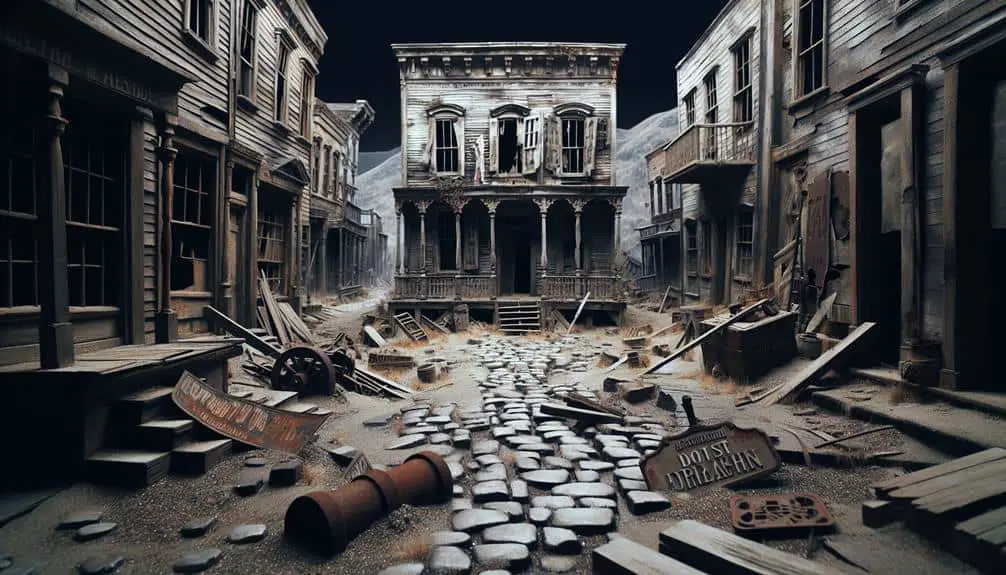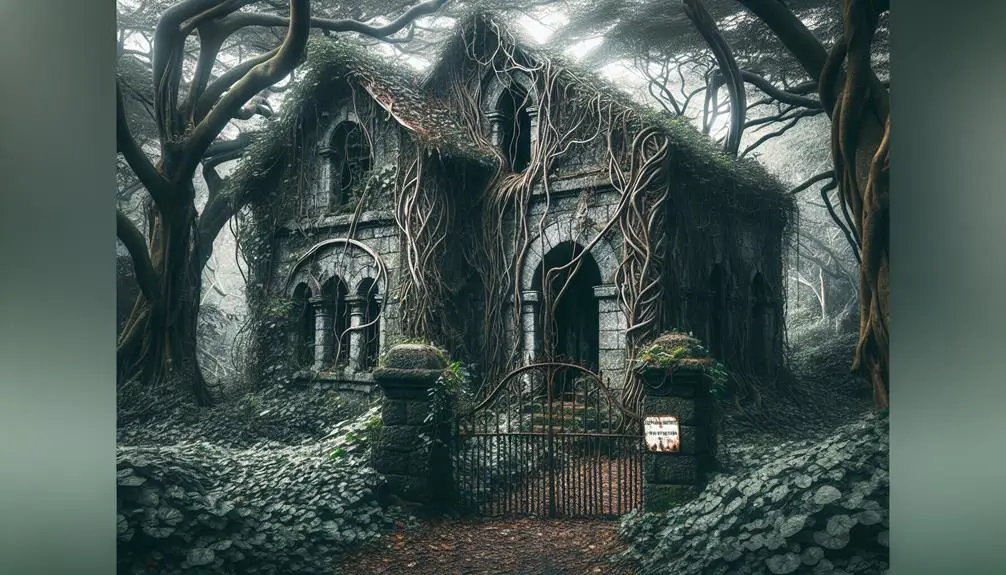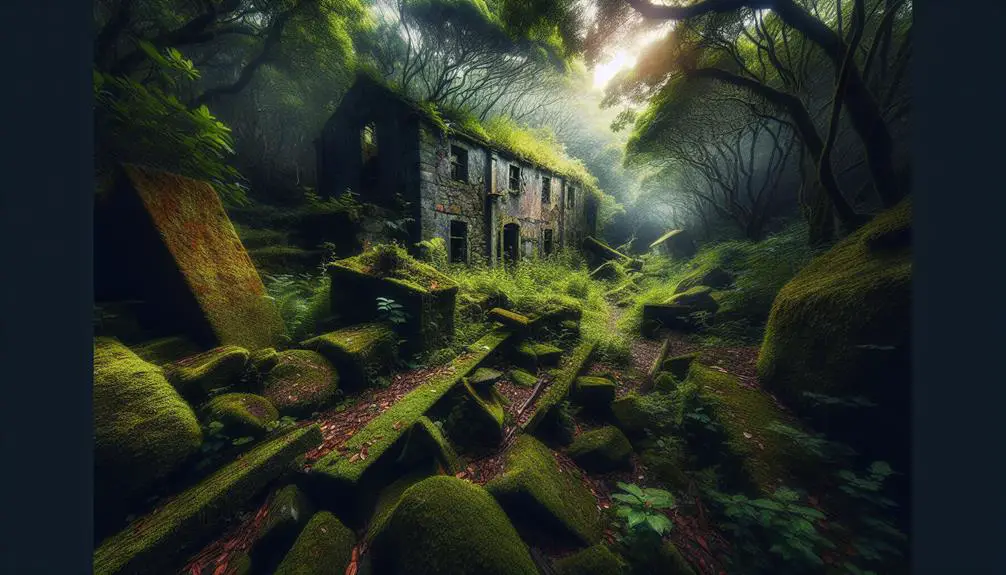When exploring colonial ghost town remnants in the US, you discover real connections to a past that shaped the country and gain insight into the lives of early settlers. Dilapidated structures reveal architectural styles of the era, each element holding a story of past inhabitants. Hidden artifacts unearth activities and customs, preserving forgotten traditions. Overgrown vegetation and eerie silence create a hauntingly beautiful backdrop. Ruins stand as silent witnesses to history, offering a unique glimpse into the past. Decaying walls and overgrown pathways provide clues to societal norms and cultural influences. Architectural details hint at untold stories waiting to be uncovered.
Key Points
- Explore dilapidated structures depicting colonial architectural styles.
- Uncover hidden artifacts revealing daily life in these ghost towns.
- Document and interpret historical remnants for cultural preservation.
- Investigate overgrown paths and structures for historical insights.
- Study decaying walls and structures for societal and cultural clues.
Colonial Era Ghost Town Origins
When examining the origins of colonial era ghost towns in the US, it becomes evident that various factors contributed to their establishment and eventual abandonment. These towns hold a significant place in American history, showcasing a blend of cultural heritage and historical significance. The establishment of these ghost towns often stemmed from economic shifts, such as the decline of industries like mining or logging, leading residents to seek opportunities elsewhere. Additionally, factors like natural disasters, changing transportation routes, or conflicts with indigenous populations played a role in the abandonment of these settlements.
The cultural heritage of colonial ghost towns lies in the architectural remnants, artifacts, and stories that have been passed down through generations. These sites offer a glimpse into the past, allowing us to learn about the daily lives, struggles, and triumphs of early American settlers. Their historical significance extends beyond mere ruins, serving as tangible links to a bygone era that shaped the nation's identity. By preserving and studying these ghost towns, we can gain a deeper understanding of our shared history and the challenges faced by those who came before us.
Significance of Colonial Ghost Towns
Investigating the importance of colonial ghost towns reveals a diverse tapestry of historical narratives and cultural heritage deeply intertwined with America's past. These remnants hold immense historical significance and provide valuable insights into the early days of settlement and exploration. The cultural heritage embedded in these ghost towns offers a glimpse into the lifestyles, traditions, and struggles of the people who once inhabited these now-abandoned places.
- Preservation of History: Colonial ghost towns serve as physical reminders of the past, preserving history for future generations to learn from.
- Architectural Diversity: The structures found in these ghost towns showcase the architectural styles prevalent during the colonial era, reflecting the skills and craftsmanship of the time.
- Economic Significance: Studying these ghost towns can shed light on the economic activities and industries that sustained early colonial settlements.
- Cultural Exchange: Interaction between different cultural groups in these towns influenced the development of unique cultural practices and beliefs.
- Community Dynamics: The layout and remnants of colonial ghost towns can offer insights into the social structures and community dynamics of bygone eras.
Preservation Efforts for Ghost Towns
Preservation initiatives for colonial ghost towns encompass a variety of strategies aimed at safeguarding these historical sites for future generations. These efforts are vital due to the historical significance these ghost towns hold in understanding the colonial past of the United States.
One key preservation initiative involves maintaining the structural integrity of buildings through restoration projects. By repairing and conserving colonial-era architecture, experts guarantee that the physical remnants of these towns are preserved for educational purposes.
Another important aspect of preservation initiatives is the documentation and interpretation of historical artifacts found within these ghost towns. Archaeological surveys and excavations help uncover valuable objects that shed light on the daily lives of early settlers. By cataloging and studying these artifacts, historians can piece together the stories of the past and provide a deeper understanding of colonial life in America.
Unique Features of Colonial Ghost Towns
Often overlooked, colonial ghost towns in the US harbor unique features that offer valuable insights into the early American settlement era. These sites aren't just abandoned remnants of the past; they're windows into a different time, revealing a treasure trove of architectural remnants and historical significance.
When you explore these locations, you'll encounter:
- Architectural Remnants: Dilapidated structures, such as old houses, churches, and mills, showcase the architectural styles of the colonial period, providing a tangible link to the past.
- Historical Significance: Each cobblestone, each weathered door, and each crumbling wall tells a story of the people who lived in these towns, offering a glimpse into their daily lives and struggles.
- Hidden Artifacts: Digging beneath the surface might reveal hidden artifacts like pottery fragments, tools, or personal items, shedding light on the activities and customs of the former inhabitants.
- Cultural Heritage: From faded murals to fading gravestones, these ghost towns preserve cultural expressions and traditions that have long been forgotten or overshadowed.
- Unique Landscapes: The overgrown vegetation and eerie silence create a hauntingly beautiful backdrop that enhances the mystique of these abandoned settlements.
Exploring Colonial Ghost Town Ruins
Among the eerie remnants of colonial ghost towns in the US, the ruins stand as silent witnesses to a bygone era, beckoning explorers to uncover their hidden stories. Exploring these architectural remains provides a unique glimpse into the historical significance of these once-thriving settlements. The decaying walls, crumbling structures, and overgrown pathways all offer clues to the lives led by the early inhabitants.
As you wander through these abandoned sites, pay close attention to the intricate details of the architecture. The design of the buildings can reveal insights into the societal norms, economic activities, and cultural influences of the time. From the layout of the streets to the materials used in construction, each element tells a part of the story waiting to be discovered.
Frequently Asked Questions
How Do Colonial Ghost Towns Impact Modern-Day Communities Near Their Ruins?
You might notice how colonial ghost towns impact nearby communities with their historical significance. Preservation efforts maintain these ruins, attracting tourists. Community impact varies, from economic boosts to cultural awareness. The balance between tourism and local needs is essential.
Are There Any Superstitions or Folklore Associated With Colonial Ghost Towns?
When it comes to folklore origins and superstition beliefs surrounding colonial ghost towns, you'll find a rich tapestry of stories passed down through generations, weaving together history, mystery, and the supernatural.
What Challenges Do Archaeologists Face When Excavating Colonial Ghost Town Sites?
When excavating colonial ghost town sites, archaeologists face numerous challenges such as unstable structures, limited funding, and the need to balance excavation with preservation efforts. These obstacles require careful planning and expertise to navigate successfully.
Have Any Paranormal Investigations or Ghost Hunting Activities Been Conducted in Colonial Ghost Towns?
Have paranormal investigations occurred in colonial ghost towns? These activities can uncover cultural significance while blending ghost hunting with historical preservation. Exploring these sites through such lenses can offer unique insights into the past.
How Do Colonial Ghost Towns Compare to Other Types of Abandoned Settlements, Such as Mining Towns or Frontier Outposts?
Comparing colonial ghost towns to mining towns or frontier outposts showcases unique historical narratives. Preservation efforts prioritize understanding varied contexts. While mining towns focus on resource extraction, frontier outposts symbolize expansion, colonial ghost towns capture early settlement challenges and societal shifts.



